Application of Stakeholder Theory in Banking Sector Analysis
VerifiedAdded on 2023/06/05
|9
|2244
|134
Report
AI Summary
This report investigates the application of stakeholder theory within the banking sector, emphasizing the importance of stakeholder engagement for long-term sustainability. It examines the NAB and CBA case studies, analyzing the impact of stakeholder considerations on business outcomes. The study applies positive accounting theory, specifically the political cost hypothesis, and legitimacy theory to understand stakeholder engagement. The report analyzes how the banks' actions, or lack thereof, regarding small business concerns and misleading practices towards investors, impact stakeholder relationships. The conclusion highlights the necessity of adopting stakeholder theory, incorporating the principles of positive accounting theory and legitimacy theory, for the success of banking organizations.

qwertyuiopasdfghjklzxcvbnmqwertyuiopasdfghjklzxcvbnmqwertyuiopasdfghjklzxcvbnmqwertyuio
pasdfghjklzxcvbnmqwertyuiopasdfghjklzxcvbnmqwertyuiopasdfghjklzxcvbnmqwertyuiopasdfghjkl
zxcvbnmqwertyuiopasdfghjklzxcvbnmqwertyuiopasdfghjklzxcvbnmqwertyuiopasdfghjklzxcvbnmq
wertyuiopasdfghjklzxcvbnmqwertyuiopasdfghjklzxcvbnmqwertyuiopasdfghjklzxcvbnmqwertyuiop
asdfghjklzxcvbnmqwertyuiopasdfghjklzxcvbnmqwertyuiopasdfghjklzxcvbnmqwertyuiopasdfghjklz
xcvbnmqwertyuiopasdfghjklzxcvbnmrtyuiopasdfghjklzxcvbnmqwertyuiopasdfghjklzxcvbnmqwerty
uiopasdfghjklzxcvbnmqwertyuiopasdfghjklzxcvbnmqwertyuiopasdfghjklzxcvbnmqwertyuiopasdfg
hjklzxcvbnmqwertyuiopasdfghjklzxcvbnmqwertyuiopasdfghjklzxcvbnmqwertyuiopasdfghjklzxcvbn
mqwertyuiopasdfghjklzxcvbnmqwertyuiopasdfghjklzxcvbnmqwertyuiopasdfghjklzxcvbnmqwertyu
iopasdfghjklzxcvbnmrtyuiopasdfghjklzxcvbnmqwertyuiopasdfghjklzxcvbnmqwertyuiopasdfghjklzx
cvbnmqwertyuiopasdfghjklzxcvbnmqwertyuiopasdfghjklzxcvbnmqwertyuiopasdfghjklzxcvbnmqw
ertyuiopasdfghjklzxcvbnmqwertyuiopasdfghjklzxcvbnmqwertyuiopasdfghjklzxcvbnmqwertyuiopas
dfghjklzxcvbnmqwertyuiopasdfghjklzxcvbnmqwertyuiopasdfghjklzxcvbnmqwertyuiopasdfghjklzxc
vbnmrtyuiopasdfghjklzxcvbnmqwertyuiopasdfghjklzxcvbnmqwertyuiopasdfghjklzxcvbnmqwertyui
opasdfghjklzxcvbnmqwertyuiopasdfghjklzxcvbnmqwertyuiopasdfghjklzxcvbnmqwertyuiopasdfghj
klzxcvbnmqwertyuiopasdfghjklzxcPrepared
Byvbnmqwertyuiopasdfghjklzxcvbnmqwertyuiopasdfghjklzxcvbnmqwertyuiopasdfghjklzxcvbnmq
wertyuiopasdfghjklzxcvbnmqwertyuiopasdfghjklzxcvbnmrtyuiopasdfghjklzxcvbnmqwertyuiopasdf
ghjklzxcvbnmqwertyuiopasdfghjklzxcvbnmqwertyuiopasdfghjklzxcvbnmqwertyuiopasdfghjklzxcvb
nmqwertyuiopasdfghjklzxcvbnmqwertyuiopasdfghjklzxcvbnmqwertyuiopasdfghjklzxcvbnmqwerty
uiopasdfghjklzxcvbnmqwertyuiopasdfghjklzxcvbnmqwertyuiopasdfghjklzxcvbnmqwertyuiopasdfg
hjklzxcvbnmqwertyuiopasdfghjklzxcvbnmrtyuiopasdfghjklzxcvbnmqwertyuiopasdfghjklzxcvbnmq
wertyuiopasdfghjklzxcvbnmqwertyuiopasdfghjklzxcvbnmqwertyuiopasdfghjklzxcvbnmqwertyuiop
asdfghjklzxcvbnmqwertyuiopasdfghjklzxcvbnmqwertyuiopasdfghjklzxcvbnmqwertyuiopasdfghjklz
xcvbnmqwertyuiopasdfghjklzxcvbnmqwertyuiopasdfghjklzxcvbnmqwertyuiopasdfghjklzxcvbnmq
wertyuiopasdfghjklzxcvbnmrtyuiopasdfghjklzxcvbnmqwertyuiopasdfghjklzxcvbnmqwertyuiopasdf
ghjklzxcvbnmqwertyuiopasdfghjklzxcvbnmqwertyuiopasdfghjklzxcvbnmqwertyuiopasdfghjklzxcvb
nmqwertyuiopasdfghjklzxcvbnmqwertyuiopasdfghjklzxcvbnmqwertyuiopasdfghjklzxcvbnmqwerty
uiopasdfghjklzxcvbnmqwertyuiopasdfghjklzxcvbnmqwertyuiopasdfghjklzxcvbnmqwertyuiopasdfg
hjklzxcvbnmrtyuiopasdfghjklzxcvbnmqwertyuiopasdfghjklzxcvbnmqwertyuiopasdfghjklzxcvbnmq
wertyuiopasdfghjklzxcvbnmqwertyuiopasdfghjklzxcvbnmqwertyuiopasdfghjklzxcvbnmqwertyuiop
asdfghjklzxcvbnmqwertyuiopasdfghjklzxcvbnmqwertyuiopasdfghjklzxcvbnmqwertyuiopasdfghjklz
xcvbnmqwertyuiopasdfghjklzxcvbnmqwertyuiopasdfghjklzxcvbnmqwertyuiopasdfghjklzxcvbnmq
wwertyuiopasdfghjklzxcvbnmqwertyuiopasdfghjklzxcvbnmqwertyuiopasdfghjklzxcvbnmqwertyui
opasdfghjklzxcvbnm27
An Application of
Stakeholder’s Theory in the Banking
Institutions
Prepared By
Student Name:
Student ID :
Student Name :
Student ID :
pasdfghjklzxcvbnmqwertyuiopasdfghjklzxcvbnmqwertyuiopasdfghjklzxcvbnmqwertyuiopasdfghjkl
zxcvbnmqwertyuiopasdfghjklzxcvbnmqwertyuiopasdfghjklzxcvbnmqwertyuiopasdfghjklzxcvbnmq
wertyuiopasdfghjklzxcvbnmqwertyuiopasdfghjklzxcvbnmqwertyuiopasdfghjklzxcvbnmqwertyuiop
asdfghjklzxcvbnmqwertyuiopasdfghjklzxcvbnmqwertyuiopasdfghjklzxcvbnmqwertyuiopasdfghjklz
xcvbnmqwertyuiopasdfghjklzxcvbnmrtyuiopasdfghjklzxcvbnmqwertyuiopasdfghjklzxcvbnmqwerty
uiopasdfghjklzxcvbnmqwertyuiopasdfghjklzxcvbnmqwertyuiopasdfghjklzxcvbnmqwertyuiopasdfg
hjklzxcvbnmqwertyuiopasdfghjklzxcvbnmqwertyuiopasdfghjklzxcvbnmqwertyuiopasdfghjklzxcvbn
mqwertyuiopasdfghjklzxcvbnmqwertyuiopasdfghjklzxcvbnmqwertyuiopasdfghjklzxcvbnmqwertyu
iopasdfghjklzxcvbnmrtyuiopasdfghjklzxcvbnmqwertyuiopasdfghjklzxcvbnmqwertyuiopasdfghjklzx
cvbnmqwertyuiopasdfghjklzxcvbnmqwertyuiopasdfghjklzxcvbnmqwertyuiopasdfghjklzxcvbnmqw
ertyuiopasdfghjklzxcvbnmqwertyuiopasdfghjklzxcvbnmqwertyuiopasdfghjklzxcvbnmqwertyuiopas
dfghjklzxcvbnmqwertyuiopasdfghjklzxcvbnmqwertyuiopasdfghjklzxcvbnmqwertyuiopasdfghjklzxc
vbnmrtyuiopasdfghjklzxcvbnmqwertyuiopasdfghjklzxcvbnmqwertyuiopasdfghjklzxcvbnmqwertyui
opasdfghjklzxcvbnmqwertyuiopasdfghjklzxcvbnmqwertyuiopasdfghjklzxcvbnmqwertyuiopasdfghj
klzxcvbnmqwertyuiopasdfghjklzxcPrepared
Byvbnmqwertyuiopasdfghjklzxcvbnmqwertyuiopasdfghjklzxcvbnmqwertyuiopasdfghjklzxcvbnmq
wertyuiopasdfghjklzxcvbnmqwertyuiopasdfghjklzxcvbnmrtyuiopasdfghjklzxcvbnmqwertyuiopasdf
ghjklzxcvbnmqwertyuiopasdfghjklzxcvbnmqwertyuiopasdfghjklzxcvbnmqwertyuiopasdfghjklzxcvb
nmqwertyuiopasdfghjklzxcvbnmqwertyuiopasdfghjklzxcvbnmqwertyuiopasdfghjklzxcvbnmqwerty
uiopasdfghjklzxcvbnmqwertyuiopasdfghjklzxcvbnmqwertyuiopasdfghjklzxcvbnmqwertyuiopasdfg
hjklzxcvbnmqwertyuiopasdfghjklzxcvbnmrtyuiopasdfghjklzxcvbnmqwertyuiopasdfghjklzxcvbnmq
wertyuiopasdfghjklzxcvbnmqwertyuiopasdfghjklzxcvbnmqwertyuiopasdfghjklzxcvbnmqwertyuiop
asdfghjklzxcvbnmqwertyuiopasdfghjklzxcvbnmqwertyuiopasdfghjklzxcvbnmqwertyuiopasdfghjklz
xcvbnmqwertyuiopasdfghjklzxcvbnmqwertyuiopasdfghjklzxcvbnmqwertyuiopasdfghjklzxcvbnmq
wertyuiopasdfghjklzxcvbnmrtyuiopasdfghjklzxcvbnmqwertyuiopasdfghjklzxcvbnmqwertyuiopasdf
ghjklzxcvbnmqwertyuiopasdfghjklzxcvbnmqwertyuiopasdfghjklzxcvbnmqwertyuiopasdfghjklzxcvb
nmqwertyuiopasdfghjklzxcvbnmqwertyuiopasdfghjklzxcvbnmqwertyuiopasdfghjklzxcvbnmqwerty
uiopasdfghjklzxcvbnmqwertyuiopasdfghjklzxcvbnmqwertyuiopasdfghjklzxcvbnmqwertyuiopasdfg
hjklzxcvbnmrtyuiopasdfghjklzxcvbnmqwertyuiopasdfghjklzxcvbnmqwertyuiopasdfghjklzxcvbnmq
wertyuiopasdfghjklzxcvbnmqwertyuiopasdfghjklzxcvbnmqwertyuiopasdfghjklzxcvbnmqwertyuiop
asdfghjklzxcvbnmqwertyuiopasdfghjklzxcvbnmqwertyuiopasdfghjklzxcvbnmqwertyuiopasdfghjklz
xcvbnmqwertyuiopasdfghjklzxcvbnmqwertyuiopasdfghjklzxcvbnmqwertyuiopasdfghjklzxcvbnmq
wwertyuiopasdfghjklzxcvbnmqwertyuiopasdfghjklzxcvbnmqwertyuiopasdfghjklzxcvbnmqwertyui
opasdfghjklzxcvbnm27
An Application of
Stakeholder’s Theory in the Banking
Institutions
Prepared By
Student Name:
Student ID :
Student Name :
Student ID :
Paraphrase This Document
Need a fresh take? Get an instant paraphrase of this document with our AI Paraphraser
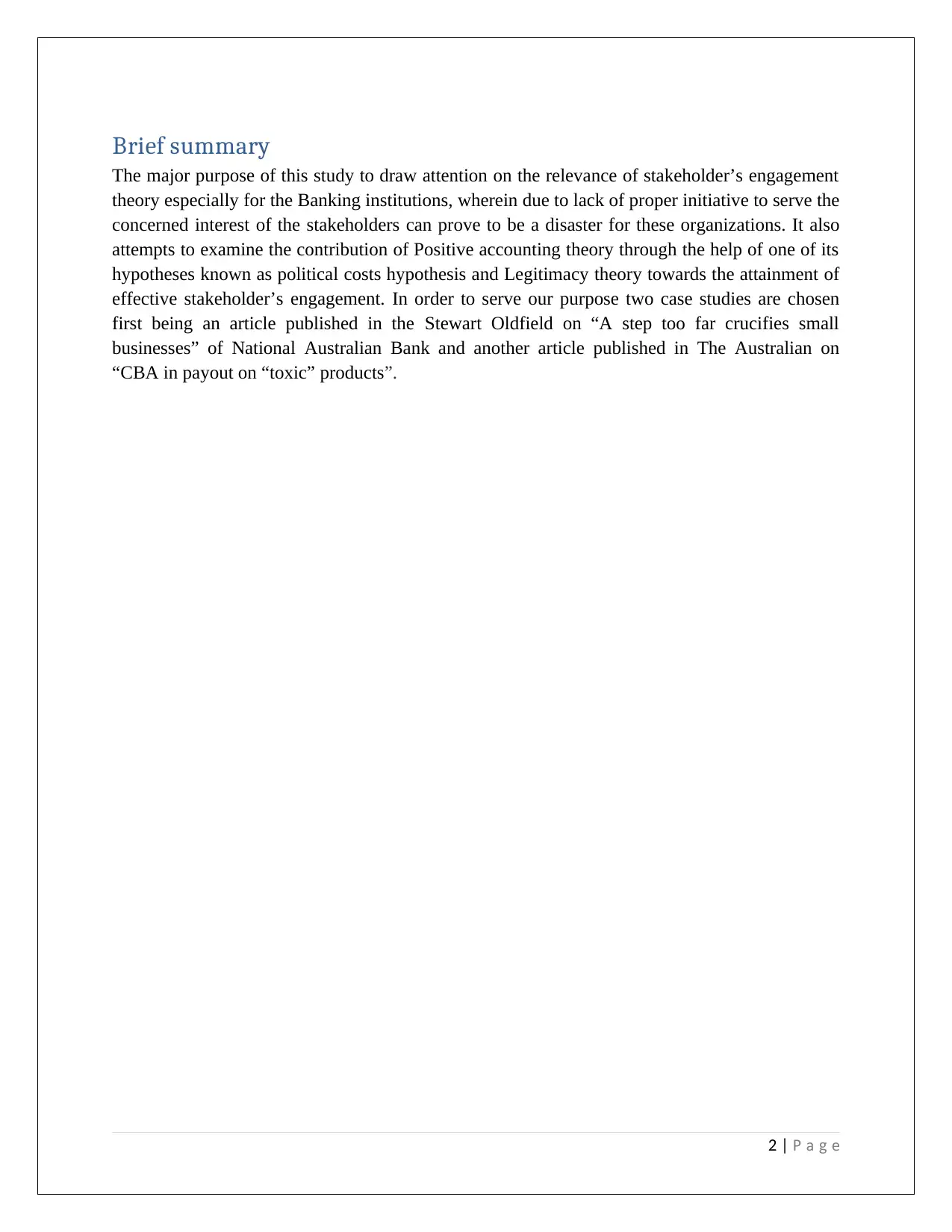
Brief summary
The major purpose of this study to draw attention on the relevance of stakeholder’s engagement
theory especially for the Banking institutions, wherein due to lack of proper initiative to serve the
concerned interest of the stakeholders can prove to be a disaster for these organizations. It also
attempts to examine the contribution of Positive accounting theory through the help of one of its
hypotheses known as political costs hypothesis and Legitimacy theory towards the attainment of
effective stakeholder’s engagement. In order to serve our purpose two case studies are chosen
first being an article published in the Stewart Oldfield on “A step too far crucifies small
businesses” of National Australian Bank and another article published in The Australian on
“CBA in payout on “toxic” products”.
2 | P a eg
The major purpose of this study to draw attention on the relevance of stakeholder’s engagement
theory especially for the Banking institutions, wherein due to lack of proper initiative to serve the
concerned interest of the stakeholders can prove to be a disaster for these organizations. It also
attempts to examine the contribution of Positive accounting theory through the help of one of its
hypotheses known as political costs hypothesis and Legitimacy theory towards the attainment of
effective stakeholder’s engagement. In order to serve our purpose two case studies are chosen
first being an article published in the Stewart Oldfield on “A step too far crucifies small
businesses” of National Australian Bank and another article published in The Australian on
“CBA in payout on “toxic” products”.
2 | P a eg
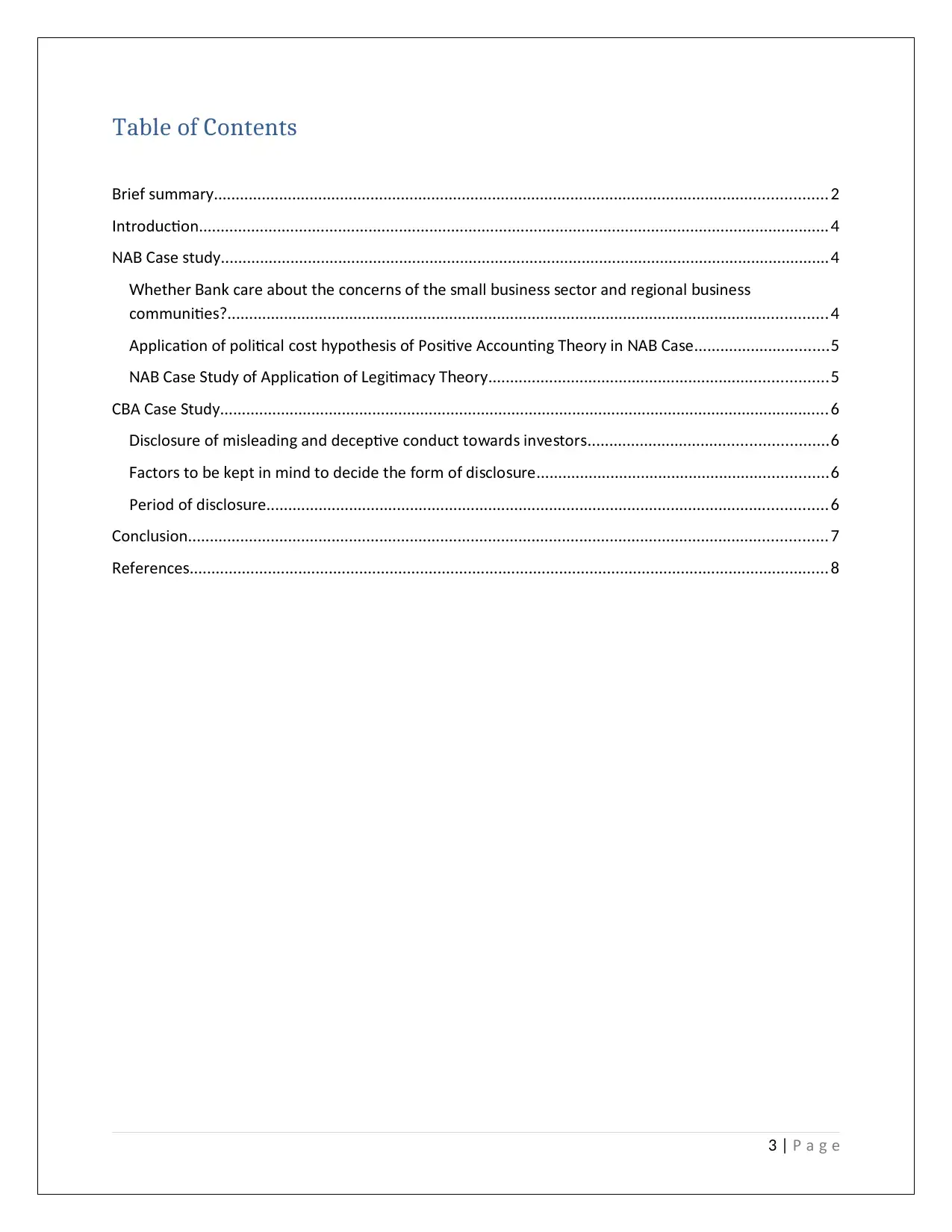
Table of Contents
rie mmarB f su y.............................................................................................................................................2
ntrod ctionI u .................................................................................................................................................4
A a e t dN B C s s u y............................................................................................................................................4
et er anWh h B k care a o t t e concern o t e mall ine ector and re ional ineb u h s f h s bus ss s g bus ss
comm nitieu s?..........................................................................................................................................4
Application o politicalf co t pot e i o Po iti e Acco ntin T eor in A a es hy h s s f s v u g h y N B C s ...............................5
A a e t d o Application o e itimac T eorN B C s S u y f f L g y h y..............................................................................5
A a e t dCB C s S u y............................................................................................................................................6
i clo re o mi leadin and decepti e cond ct to ard in e torD s su f s g v u w s v s s.......................................................6
actor to e ept in mind to decide t e orm o di clo reF s b k h f f s su ...................................................................6
Period o di clo ref s su .................................................................................................................................6
oncl ionC us ...................................................................................................................................................7
e erenceR f s...................................................................................................................................................8
3 | P a eg
rie mmarB f su y.............................................................................................................................................2
ntrod ctionI u .................................................................................................................................................4
A a e t dN B C s s u y............................................................................................................................................4
et er anWh h B k care a o t t e concern o t e mall ine ector and re ional ineb u h s f h s bus ss s g bus ss
comm nitieu s?..........................................................................................................................................4
Application o politicalf co t pot e i o Po iti e Acco ntin T eor in A a es hy h s s f s v u g h y N B C s ...............................5
A a e t d o Application o e itimac T eorN B C s S u y f f L g y h y..............................................................................5
A a e t dCB C s S u y............................................................................................................................................6
i clo re o mi leadin and decepti e cond ct to ard in e torD s su f s g v u w s v s s.......................................................6
actor to e ept in mind to decide t e orm o di clo reF s b k h f f s su ...................................................................6
Period o di clo ref s su .................................................................................................................................6
oncl ionC us ...................................................................................................................................................7
e erenceR f s...................................................................................................................................................8
3 | P a eg
⊘ This is a preview!⊘
Do you want full access?
Subscribe today to unlock all pages.

Trusted by 1+ million students worldwide
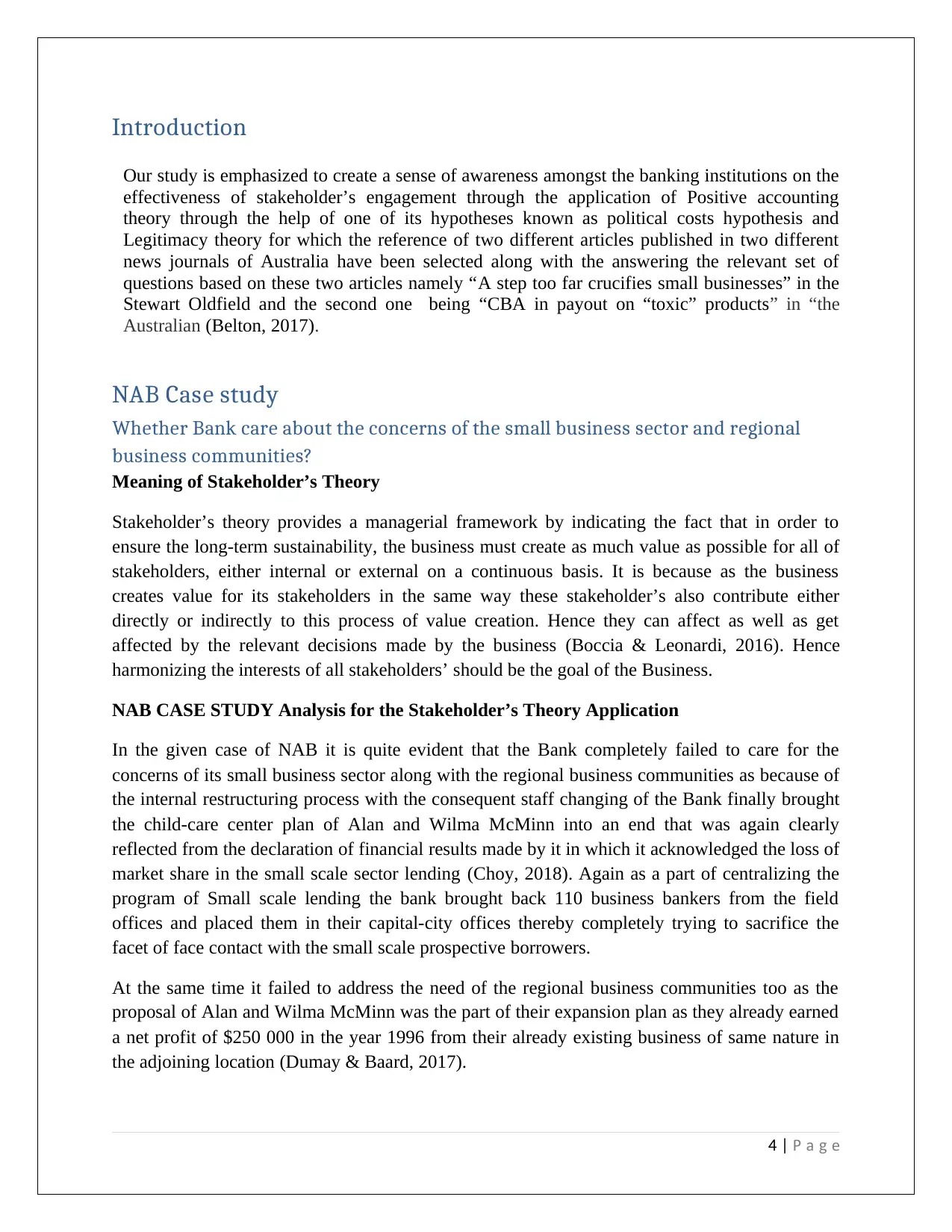
Introduction
Our study is emphasized to create a sense of awareness amongst the banking institutions on the
effectiveness of stakeholder’s engagement through the application of Positive accounting
theory through the help of one of its hypotheses known as political costs hypothesis and
Legitimacy theory for which the reference of two different articles published in two different
news journals of Australia have been selected along with the answering the relevant set of
questions based on these two articles namely “A step too far crucifies small businesses” in the
Stewart Oldfield and the second one being “CBA in payout on “toxic” products” in “the
Australian (Belton, 2017).
NAB Case study
Whether Bank care about the concerns of the small business sector and regional
business communities?
Meaning of Stakeholder’s Theory
Stakeholder’s theory provides a managerial framework by indicating the fact that in order to
ensure the long-term sustainability, the business must create as much value as possible for all of
stakeholders, either internal or external on a continuous basis. It is because as the business
creates value for its stakeholders in the same way these stakeholder’s also contribute either
directly or indirectly to this process of value creation. Hence they can affect as well as get
affected by the relevant decisions made by the business (Boccia & Leonardi, 2016). Hence
harmonizing the interests of all stakeholders’ should be the goal of the Business.
NAB CASE STUDY Analysis for the Stakeholder’s Theory Application
In the given case of NAB it is quite evident that the Bank completely failed to care for the
concerns of its small business sector along with the regional business communities as because of
the internal restructuring process with the consequent staff changing of the Bank finally brought
the child-care center plan of Alan and Wilma McMinn into an end that was again clearly
reflected from the declaration of financial results made by it in which it acknowledged the loss of
market share in the small scale sector lending (Choy, 2018). Again as a part of centralizing the
program of Small scale lending the bank brought back 110 business bankers from the field
offices and placed them in their capital-city offices thereby completely trying to sacrifice the
facet of face contact with the small scale prospective borrowers.
At the same time it failed to address the need of the regional business communities too as the
proposal of Alan and Wilma McMinn was the part of their expansion plan as they already earned
a net profit of $250 000 in the year 1996 from their already existing business of same nature in
the adjoining location (Dumay & Baard, 2017).
4 | P a eg
Our study is emphasized to create a sense of awareness amongst the banking institutions on the
effectiveness of stakeholder’s engagement through the application of Positive accounting
theory through the help of one of its hypotheses known as political costs hypothesis and
Legitimacy theory for which the reference of two different articles published in two different
news journals of Australia have been selected along with the answering the relevant set of
questions based on these two articles namely “A step too far crucifies small businesses” in the
Stewart Oldfield and the second one being “CBA in payout on “toxic” products” in “the
Australian (Belton, 2017).
NAB Case study
Whether Bank care about the concerns of the small business sector and regional
business communities?
Meaning of Stakeholder’s Theory
Stakeholder’s theory provides a managerial framework by indicating the fact that in order to
ensure the long-term sustainability, the business must create as much value as possible for all of
stakeholders, either internal or external on a continuous basis. It is because as the business
creates value for its stakeholders in the same way these stakeholder’s also contribute either
directly or indirectly to this process of value creation. Hence they can affect as well as get
affected by the relevant decisions made by the business (Boccia & Leonardi, 2016). Hence
harmonizing the interests of all stakeholders’ should be the goal of the Business.
NAB CASE STUDY Analysis for the Stakeholder’s Theory Application
In the given case of NAB it is quite evident that the Bank completely failed to care for the
concerns of its small business sector along with the regional business communities as because of
the internal restructuring process with the consequent staff changing of the Bank finally brought
the child-care center plan of Alan and Wilma McMinn into an end that was again clearly
reflected from the declaration of financial results made by it in which it acknowledged the loss of
market share in the small scale sector lending (Choy, 2018). Again as a part of centralizing the
program of Small scale lending the bank brought back 110 business bankers from the field
offices and placed them in their capital-city offices thereby completely trying to sacrifice the
facet of face contact with the small scale prospective borrowers.
At the same time it failed to address the need of the regional business communities too as the
proposal of Alan and Wilma McMinn was the part of their expansion plan as they already earned
a net profit of $250 000 in the year 1996 from their already existing business of same nature in
the adjoining location (Dumay & Baard, 2017).
4 | P a eg
Paraphrase This Document
Need a fresh take? Get an instant paraphrase of this document with our AI Paraphraser
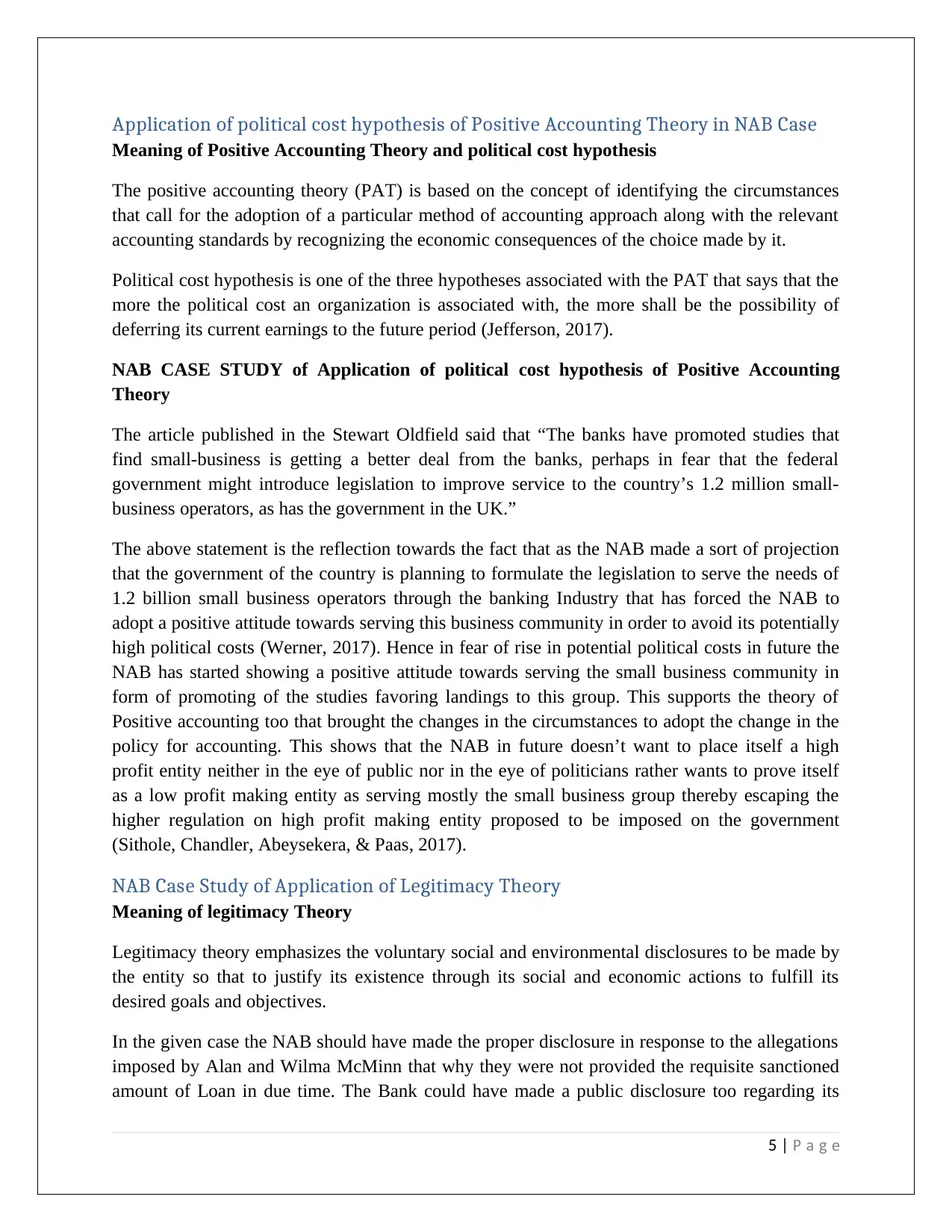
Application of political cost hypothesis of Positive Accounting Theory in NAB Case
Meaning of Positive Accounting Theory and political cost hypothesis
The positive accounting theory (PAT) is based on the concept of identifying the circumstances
that call for the adoption of a particular method of accounting approach along with the relevant
accounting standards by recognizing the economic consequences of the choice made by it.
Political cost hypothesis is one of the three hypotheses associated with the PAT that says that the
more the political cost an organization is associated with, the more shall be the possibility of
deferring its current earnings to the future period (Jefferson, 2017).
NAB CASE STUDY of Application of political cost hypothesis of Positive Accounting
Theory
The article published in the Stewart Oldfield said that “The banks have promoted studies that
find small-business is getting a better deal from the banks, perhaps in fear that the federal
government might introduce legislation to improve service to the country’s 1.2 million small-
business operators, as has the government in the UK.”
The above statement is the reflection towards the fact that as the NAB made a sort of projection
that the government of the country is planning to formulate the legislation to serve the needs of
1.2 billion small business operators through the banking Industry that has forced the NAB to
adopt a positive attitude towards serving this business community in order to avoid its potentially
high political costs (Werner, 2017). Hence in fear of rise in potential political costs in future the
NAB has started showing a positive attitude towards serving the small business community in
form of promoting of the studies favoring landings to this group. This supports the theory of
Positive accounting too that brought the changes in the circumstances to adopt the change in the
policy for accounting. This shows that the NAB in future doesn’t want to place itself a high
profit entity neither in the eye of public nor in the eye of politicians rather wants to prove itself
as a low profit making entity as serving mostly the small business group thereby escaping the
higher regulation on high profit making entity proposed to be imposed on the government
(Sithole, Chandler, Abeysekera, & Paas, 2017).
NAB Case Study of Application of Legitimacy Theory
Meaning of legitimacy Theory
Legitimacy theory emphasizes the voluntary social and environmental disclosures to be made by
the entity so that to justify its existence through its social and economic actions to fulfill its
desired goals and objectives.
In the given case the NAB should have made the proper disclosure in response to the allegations
imposed by Alan and Wilma McMinn that why they were not provided the requisite sanctioned
amount of Loan in due time. The Bank could have made a public disclosure too regarding its
5 | P a eg
Meaning of Positive Accounting Theory and political cost hypothesis
The positive accounting theory (PAT) is based on the concept of identifying the circumstances
that call for the adoption of a particular method of accounting approach along with the relevant
accounting standards by recognizing the economic consequences of the choice made by it.
Political cost hypothesis is one of the three hypotheses associated with the PAT that says that the
more the political cost an organization is associated with, the more shall be the possibility of
deferring its current earnings to the future period (Jefferson, 2017).
NAB CASE STUDY of Application of political cost hypothesis of Positive Accounting
Theory
The article published in the Stewart Oldfield said that “The banks have promoted studies that
find small-business is getting a better deal from the banks, perhaps in fear that the federal
government might introduce legislation to improve service to the country’s 1.2 million small-
business operators, as has the government in the UK.”
The above statement is the reflection towards the fact that as the NAB made a sort of projection
that the government of the country is planning to formulate the legislation to serve the needs of
1.2 billion small business operators through the banking Industry that has forced the NAB to
adopt a positive attitude towards serving this business community in order to avoid its potentially
high political costs (Werner, 2017). Hence in fear of rise in potential political costs in future the
NAB has started showing a positive attitude towards serving the small business community in
form of promoting of the studies favoring landings to this group. This supports the theory of
Positive accounting too that brought the changes in the circumstances to adopt the change in the
policy for accounting. This shows that the NAB in future doesn’t want to place itself a high
profit entity neither in the eye of public nor in the eye of politicians rather wants to prove itself
as a low profit making entity as serving mostly the small business group thereby escaping the
higher regulation on high profit making entity proposed to be imposed on the government
(Sithole, Chandler, Abeysekera, & Paas, 2017).
NAB Case Study of Application of Legitimacy Theory
Meaning of legitimacy Theory
Legitimacy theory emphasizes the voluntary social and environmental disclosures to be made by
the entity so that to justify its existence through its social and economic actions to fulfill its
desired goals and objectives.
In the given case the NAB should have made the proper disclosure in response to the allegations
imposed by Alan and Wilma McMinn that why they were not provided the requisite sanctioned
amount of Loan in due time. The Bank could have made a public disclosure too regarding its
5 | P a eg
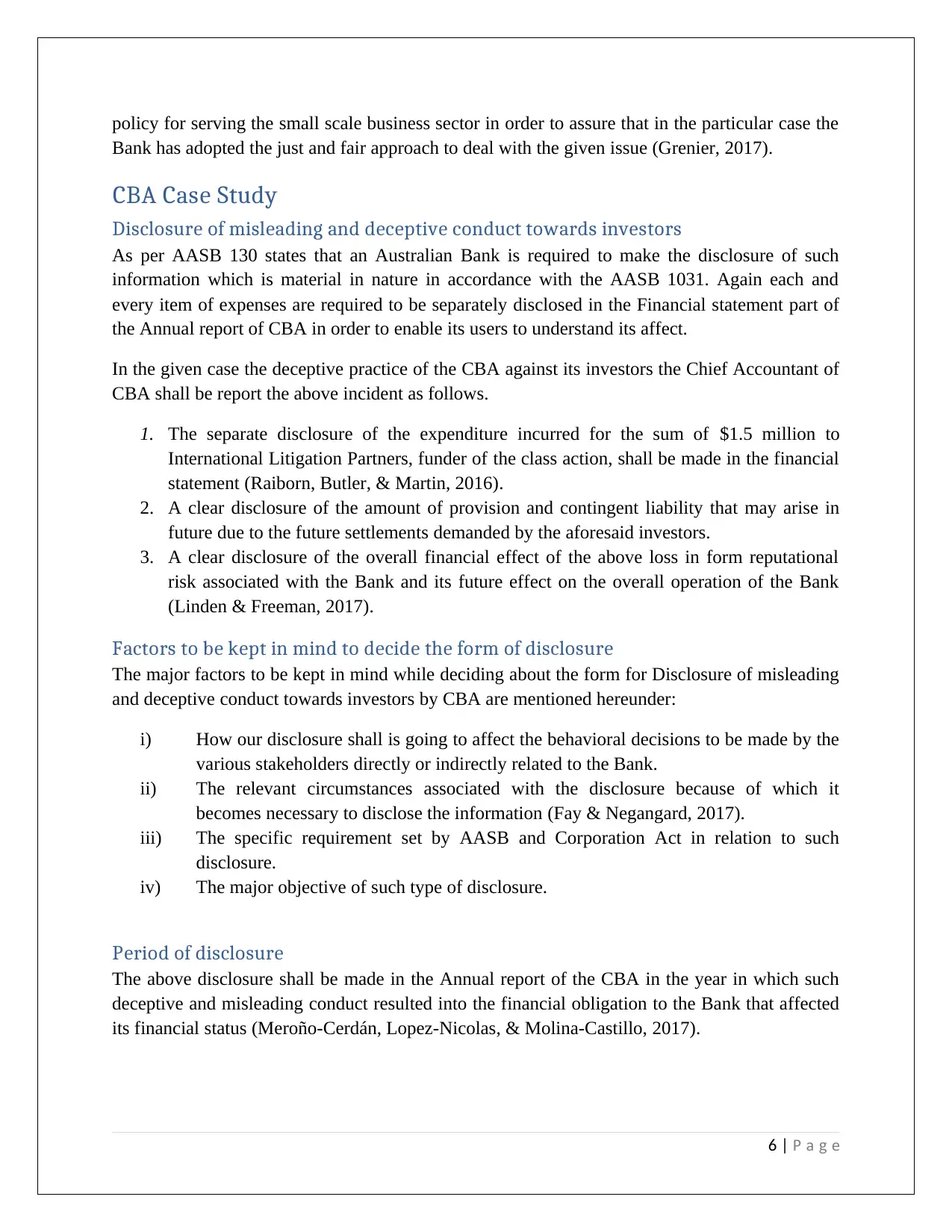
policy for serving the small scale business sector in order to assure that in the particular case the
Bank has adopted the just and fair approach to deal with the given issue (Grenier, 2017).
CBA Case Study
Disclosure of misleading and deceptive conduct towards investors
As per AASB 130 states that an Australian Bank is required to make the disclosure of such
information which is material in nature in accordance with the AASB 1031. Again each and
every item of expenses are required to be separately disclosed in the Financial statement part of
the Annual report of CBA in order to enable its users to understand its affect.
In the given case the deceptive practice of the CBA against its investors the Chief Accountant of
CBA shall be report the above incident as follows.
1. The separate disclosure of the expenditure incurred for the sum of $1.5 million to
International Litigation Partners, funder of the class action, shall be made in the financial
statement (Raiborn, Butler, & Martin, 2016).
2. A clear disclosure of the amount of provision and contingent liability that may arise in
future due to the future settlements demanded by the aforesaid investors.
3. A clear disclosure of the overall financial effect of the above loss in form reputational
risk associated with the Bank and its future effect on the overall operation of the Bank
(Linden & Freeman, 2017).
Factors to be kept in mind to decide the form of disclosure
The major factors to be kept in mind while deciding about the form for Disclosure of misleading
and deceptive conduct towards investors by CBA are mentioned hereunder:
i) How our disclosure shall is going to affect the behavioral decisions to be made by the
various stakeholders directly or indirectly related to the Bank.
ii) The relevant circumstances associated with the disclosure because of which it
becomes necessary to disclose the information (Fay & Negangard, 2017).
iii) The specific requirement set by AASB and Corporation Act in relation to such
disclosure.
iv) The major objective of such type of disclosure.
Period of disclosure
The above disclosure shall be made in the Annual report of the CBA in the year in which such
deceptive and misleading conduct resulted into the financial obligation to the Bank that affected
its financial status (Meroño-Cerdán, Lopez-Nicolas, & Molina-Castillo, 2017).
6 | P a eg
Bank has adopted the just and fair approach to deal with the given issue (Grenier, 2017).
CBA Case Study
Disclosure of misleading and deceptive conduct towards investors
As per AASB 130 states that an Australian Bank is required to make the disclosure of such
information which is material in nature in accordance with the AASB 1031. Again each and
every item of expenses are required to be separately disclosed in the Financial statement part of
the Annual report of CBA in order to enable its users to understand its affect.
In the given case the deceptive practice of the CBA against its investors the Chief Accountant of
CBA shall be report the above incident as follows.
1. The separate disclosure of the expenditure incurred for the sum of $1.5 million to
International Litigation Partners, funder of the class action, shall be made in the financial
statement (Raiborn, Butler, & Martin, 2016).
2. A clear disclosure of the amount of provision and contingent liability that may arise in
future due to the future settlements demanded by the aforesaid investors.
3. A clear disclosure of the overall financial effect of the above loss in form reputational
risk associated with the Bank and its future effect on the overall operation of the Bank
(Linden & Freeman, 2017).
Factors to be kept in mind to decide the form of disclosure
The major factors to be kept in mind while deciding about the form for Disclosure of misleading
and deceptive conduct towards investors by CBA are mentioned hereunder:
i) How our disclosure shall is going to affect the behavioral decisions to be made by the
various stakeholders directly or indirectly related to the Bank.
ii) The relevant circumstances associated with the disclosure because of which it
becomes necessary to disclose the information (Fay & Negangard, 2017).
iii) The specific requirement set by AASB and Corporation Act in relation to such
disclosure.
iv) The major objective of such type of disclosure.
Period of disclosure
The above disclosure shall be made in the Annual report of the CBA in the year in which such
deceptive and misleading conduct resulted into the financial obligation to the Bank that affected
its financial status (Meroño-Cerdán, Lopez-Nicolas, & Molina-Castillo, 2017).
6 | P a eg
⊘ This is a preview!⊘
Do you want full access?
Subscribe today to unlock all pages.

Trusted by 1+ million students worldwide
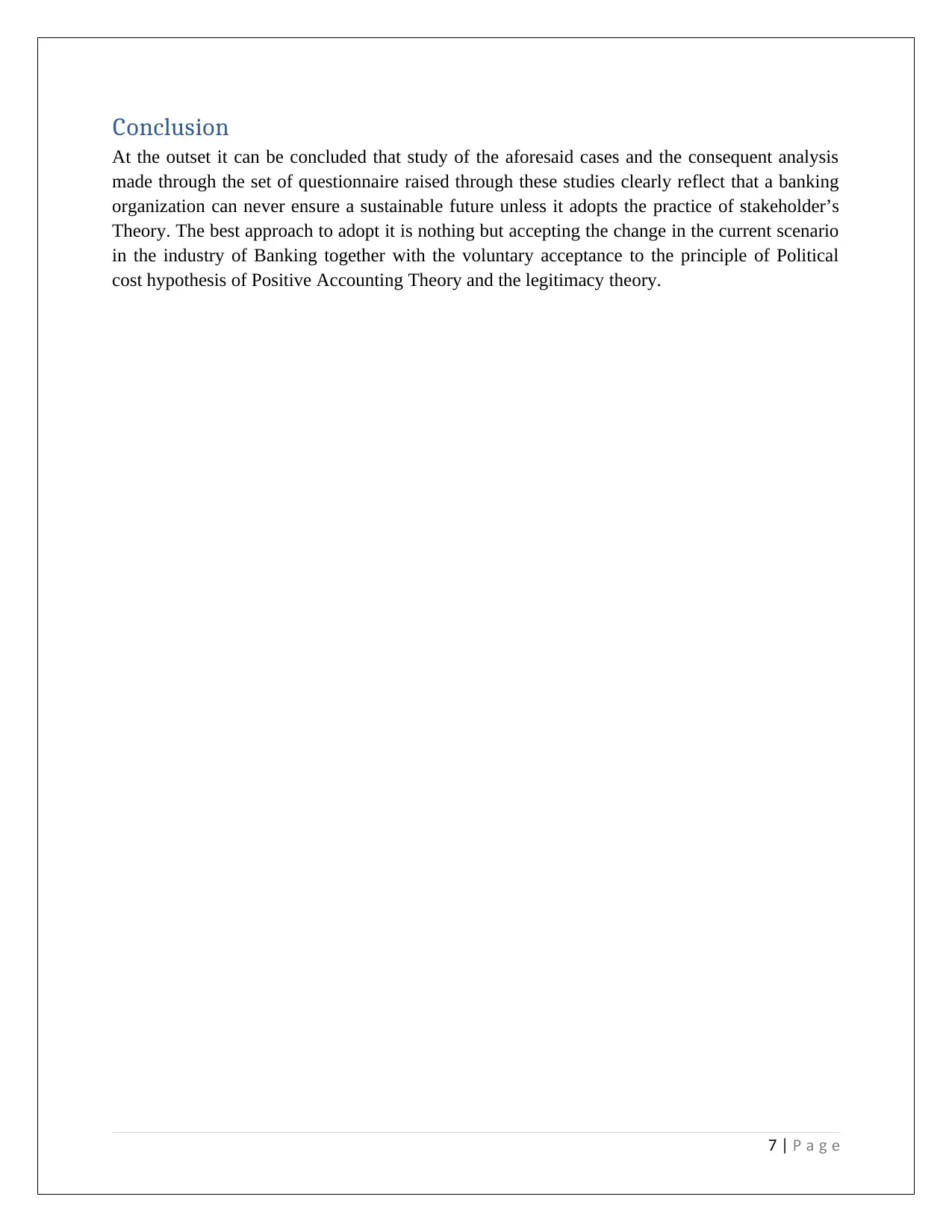
Conclusion
At the outset it can be concluded that study of the aforesaid cases and the consequent analysis
made through the set of questionnaire raised through these studies clearly reflect that a banking
organization can never ensure a sustainable future unless it adopts the practice of stakeholder’s
Theory. The best approach to adopt it is nothing but accepting the change in the current scenario
in the industry of Banking together with the voluntary acceptance to the principle of Political
cost hypothesis of Positive Accounting Theory and the legitimacy theory.
7 | P a eg
At the outset it can be concluded that study of the aforesaid cases and the consequent analysis
made through the set of questionnaire raised through these studies clearly reflect that a banking
organization can never ensure a sustainable future unless it adopts the practice of stakeholder’s
Theory. The best approach to adopt it is nothing but accepting the change in the current scenario
in the industry of Banking together with the voluntary acceptance to the principle of Political
cost hypothesis of Positive Accounting Theory and the legitimacy theory.
7 | P a eg
Paraphrase This Document
Need a fresh take? Get an instant paraphrase of this document with our AI Paraphraser

References
elton PB , . (2017).
ompetiti e trate reatin and tainin perior Per ormance
C v S gy: C g Sus g Su
f . ondon MacatL :
nternational ltd etrie ed rom ttp ro tled e com ompetiti e trate reatinI . R v f h s://www. u g . /C v -S gy-C g-
and tainin perior Per ormance elton p oo-Sus g-Su - f /B / /b k/9781912128808
occia eonardiB , F., & L , R. (2016).
T e allen e o t e i ital conom Mar et Ta ation and
h Ch g f h D g E y: k s, x
Appropriate conomic Model
E
s. prin erS g .
o o t ene it Anal i al e ell ein and t ic An ndi eno orld ieCh y, Y. K. (2018). C s -b f ys s, V u s, W b g E h s: I g us W v w
Anal iys s.
colo ical conomic
E g E s etrie ed rom, 145. R v f
ttp doi or ecoleconh s:// . g/10.1016/j. .2017.08.005
ma aard An introd ction to inter entioni t re earc in acco ntinDu y, J., & B , V. (2017). u v s s h u g.
T e o tled e
h R u g
ompanion to alitati e Acco ntin e earc Met od
C
Qu v u g R s h h s etrie ed rom, 265. R v f
ttp oo oo le co in ooh s://b ks.g g . . /b ks?
l en lr id P l AA A oi nd p PA d ma aardh = & =& = zQ Dw QB J& =f & g= 265& q=Du y,+J.,+%26+B ,+V.+(2017).
An introd ction to inter entioni t re earc in acco ntin+ + u + + v s + s h+ + u g.
T e o tled e ompanion to alitati e Acco ntin e earc Met od+ h +R u g +C + +Qu v + u g+R s h+ h s,
ot ta i T+265.& s= 1 s HB
a e an ard Man al o rnal entr te tin ata anal tic and t e ri o ra dF y, R., & N g g , E. (2017). u j u y s g : D y s h sk f f u .
o rnal o Acco ntin d cation
J u f u g E u , 38, 37-49.
renier nco ra in Pro e ional eptici m in t e nd tr peciali ation raG , J. (2017). E u g g f ss Sk s h I us y S z E .
o rnal o
J u f
ine t ic
Bus ss E h s, 142(2), 241-256.
e er on M ner omple it and ealt Ma imi ation A re prin er it erlandJ ff s , . (2017). E gy, C x y W h x z , R. y s. S g , Sw z .
Tec nolo ical oreca tin and ocial an e
h g F s g S Ch g , 353-354.
inden reeman Pro it and t er al e T ic al ation in eci ion Ma inL , B., & F , R. (2017). f O h V u s: h k Ev u D s k g.
ine
Bus ss
t ic arterl
E h s Qu y, 27 etrie ed rom ttp doi or e(3), 353-379. R v f h s:// . g/10.1017/b q.2017.1
Mero o erd n A ope icola Molina a tillo i a er ion inno ation andñ -C á , ., L z-N s, C., & -C s , F. (2017). R sk v s , v
per ormance in amil irmf f y f s.
conomic o nno ation and ne tec nolo
E s f I v
w h gy, 1-15.
ai orn tler Martin T e internal a dit nction A prere i ite or oodR b , C., Bu , J., & , K. (2016). h u fu : qu s f G
o ernanceG v .
o rnal o orporate Acco ntin and inance
J u f C
u g F , 28(2), 10-21.
it ole andler P A e e era Paa ene it o ided el mana ement oS h , S., Ch , ., b ys k , I., & s, F. (2017). B f s f gu s f- g f
attention on learnin acco nting u g.
o rnal o d cational P c olo
J u f E u
sy h gy, 109 etrie ed rom(2), 220. R v f
ttp p cnet apa orh :// sy . . g/buy/2016-21263-001
erner M inancial proce minin Acco ntin data tr ct re dependent control loW , . (2017). F ss g - u g s u u f w
in erencef .
nternational o rnal o Acco ntin n ormation tem
I
J u f u g I f
Sys s, 25, 57-80.
8 | P a eg
elton PB , . (2017).
ompetiti e trate reatin and tainin perior Per ormance
C v S gy: C g Sus g Su
f . ondon MacatL :
nternational ltd etrie ed rom ttp ro tled e com ompetiti e trate reatinI . R v f h s://www. u g . /C v -S gy-C g-
and tainin perior Per ormance elton p oo-Sus g-Su - f /B / /b k/9781912128808
occia eonardiB , F., & L , R. (2016).
T e allen e o t e i ital conom Mar et Ta ation and
h Ch g f h D g E y: k s, x
Appropriate conomic Model
E
s. prin erS g .
o o t ene it Anal i al e ell ein and t ic An ndi eno orld ieCh y, Y. K. (2018). C s -b f ys s, V u s, W b g E h s: I g us W v w
Anal iys s.
colo ical conomic
E g E s etrie ed rom, 145. R v f
ttp doi or ecoleconh s:// . g/10.1016/j. .2017.08.005
ma aard An introd ction to inter entioni t re earc in acco ntinDu y, J., & B , V. (2017). u v s s h u g.
T e o tled e
h R u g
ompanion to alitati e Acco ntin e earc Met od
C
Qu v u g R s h h s etrie ed rom, 265. R v f
ttp oo oo le co in ooh s://b ks.g g . . /b ks?
l en lr id P l AA A oi nd p PA d ma aardh = & =& = zQ Dw QB J& =f & g= 265& q=Du y,+J.,+%26+B ,+V.+(2017).
An introd ction to inter entioni t re earc in acco ntin+ + u + + v s + s h+ + u g.
T e o tled e ompanion to alitati e Acco ntin e earc Met od+ h +R u g +C + +Qu v + u g+R s h+ h s,
ot ta i T+265.& s= 1 s HB
a e an ard Man al o rnal entr te tin ata anal tic and t e ri o ra dF y, R., & N g g , E. (2017). u j u y s g : D y s h sk f f u .
o rnal o Acco ntin d cation
J u f u g E u , 38, 37-49.
renier nco ra in Pro e ional eptici m in t e nd tr peciali ation raG , J. (2017). E u g g f ss Sk s h I us y S z E .
o rnal o
J u f
ine t ic
Bus ss E h s, 142(2), 241-256.
e er on M ner omple it and ealt Ma imi ation A re prin er it erlandJ ff s , . (2017). E gy, C x y W h x z , R. y s. S g , Sw z .
Tec nolo ical oreca tin and ocial an e
h g F s g S Ch g , 353-354.
inden reeman Pro it and t er al e T ic al ation in eci ion Ma inL , B., & F , R. (2017). f O h V u s: h k Ev u D s k g.
ine
Bus ss
t ic arterl
E h s Qu y, 27 etrie ed rom ttp doi or e(3), 353-379. R v f h s:// . g/10.1017/b q.2017.1
Mero o erd n A ope icola Molina a tillo i a er ion inno ation andñ -C á , ., L z-N s, C., & -C s , F. (2017). R sk v s , v
per ormance in amil irmf f y f s.
conomic o nno ation and ne tec nolo
E s f I v
w h gy, 1-15.
ai orn tler Martin T e internal a dit nction A prere i ite or oodR b , C., Bu , J., & , K. (2016). h u fu : qu s f G
o ernanceG v .
o rnal o orporate Acco ntin and inance
J u f C
u g F , 28(2), 10-21.
it ole andler P A e e era Paa ene it o ided el mana ement oS h , S., Ch , ., b ys k , I., & s, F. (2017). B f s f gu s f- g f
attention on learnin acco nting u g.
o rnal o d cational P c olo
J u f E u
sy h gy, 109 etrie ed rom(2), 220. R v f
ttp p cnet apa orh :// sy . . g/buy/2016-21263-001
erner M inancial proce minin Acco ntin data tr ct re dependent control loW , . (2017). F ss g - u g s u u f w
in erencef .
nternational o rnal o Acco ntin n ormation tem
I
J u f u g I f
Sys s, 25, 57-80.
8 | P a eg

9 | P a eg
⊘ This is a preview!⊘
Do you want full access?
Subscribe today to unlock all pages.

Trusted by 1+ million students worldwide
1 out of 9
Related Documents
Your All-in-One AI-Powered Toolkit for Academic Success.
+13062052269
info@desklib.com
Available 24*7 on WhatsApp / Email
![[object Object]](/_next/static/media/star-bottom.7253800d.svg)
Unlock your academic potential
Copyright © 2020–2025 A2Z Services. All Rights Reserved. Developed and managed by ZUCOL.

